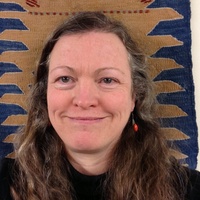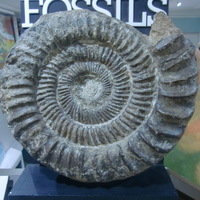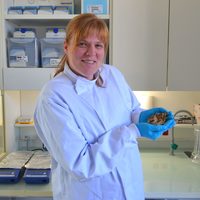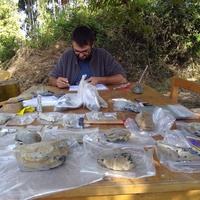
Nena Galanidou
Nena Galanidou is Professor of Prehistoric Archaeology at the University of Crete. She studied history and archaeology at the University of Crete (1988). She received an MSc in Archaeological Computing (1990) from Southampton University, UK and then worked in the Information Technology Dept. of the Benaki Museum, Athens (1989-1990). She received her PhD from the Department of Archaeology, University of Cambridge, UK (1996). Between 1996 and 1999 she taught in the same Department and was a stipendiary research fellow of Clare Hall, Cambridge. In 2000 she became an Assistant Professor and in 2009 Associate Professor of Prehistoric Archaeology at the University of Crete. Her research interests are Stone Age archaeology, public archaeology, ethnoarchaeology, and archaeological history and method. She has published in World Archaeology, the Journal of Anthropological Archaeology, the Journal of Archaeological Science, the Journal of Field Archaeology, Antiquity, Current Anthropology. She is an associate editor of Archaeological and Anthropological Sciences and Journal of Greek Archaeology. She is scientific director of the Public Archaeology series by Kaleidoscope Editions, Athens. She is a member of the SPLASHCOS (Submerged Prehistoric Landscapes and Archaeology of the Continental Shelf) network, the SUBLAND working group, the AGE (Archaeology and Gender in Europe) network and the INNOVARCH (Innovating Training Aims for Public Archaeology) group funded by Erasmus+. She has conducted Palaeolithic and Mesolithic fieldwork in Greece and Croatia. She directs two field projects addressing the Middle Pleistocene archaeology of Greece on Lesbos in the NE Aegean Sea and on Kythros, an islet in the Inner Ionian Sea.
More information on her research can be found here:
http://www.history-archaeology.uoc.gr/activities/excavations/Paleolithic-Lesvos2.html
http://www.history-archaeology.uoc.gr/activities/excavations/Paleolithic-Lefkada.html
http://pagines.uab.cat/innovarch/
More information on her research can be found here:
http://www.history-archaeology.uoc.gr/activities/excavations/Paleolithic-Lesvos2.html
http://www.history-archaeology.uoc.gr/activities/excavations/Paleolithic-Lefkada.html
http://pagines.uab.cat/innovarch/
less
Related Authors
Nerissa Russell
Cornell University
Andrei Dorian Soficaru
Institutul de Antropologie “Francisc J. Rainer”
Tristan Carter
McMaster University
Karen Ruebens
University of Reading
Armando Marques-Guedes
UNL - New University of Lisbon
Paul Arthur
University of Salento
John Sutton
Macquarie University
Yannis Hamilakis
Brown University
Gary Feinman
Field Museum
Eduardo Méndez-Quintas
Universidade de Vigo
InterestsView All (19)









Uploads
Papers by Nena Galanidou
Survey projects conducted on islands of the Central Ionian Sea during the last two decades, at the Inner Ionian Sea Archipelago and at the Livatho Valley, Kefalonia by the University of Crete and the Irish Institute of Hellenic Studies respectively, in collaboration with the 34th and 35th Ephorate of Antiquities of the Greek Ministry of Culture, provide new, critical evidence and reveal the geographic extent of Pleistocene activity and the mobility patterns occurring in western Greece since at least the Middle Palaeolithic.
Την τελευταία εικοσαετία η παλαιολιθική έρευνα στη Θεσπρωτία προωθήθηκε περαιτέρω μέσα από τα σημαντικά προγράμματα της Η΄ και ΛΒ΄ Εφορείας Αρχαιοτήτων και του Φινλανδικού Ινστιτούτου στην Αθήνα (Thesprotia Expedition) με τη διεξαγωγή εκτεταμένων ανασκαφών και επιφανειακών ερευνών σε χώρους προϊστορικής δραστηριότητας, προσφέροντας ένα μεγάλο όγκο καινούργιων πρωτογενών δεδομένων.
Η συστηματική μελέτη, διεπιστημονική αξιολόγηση και συγκριτική θεώρηση των νέων αυτών στοιχείων εμπλουτίζει τις γνώσεις και αναθεωρεί παλιότερες ερμηνευτικές προσεγγίσεις για τη ζωή του παλαιολιθικού ανθρώπου, καθιστώντας την περιοχή βασικό σημείο αναφοράς στις προσπάθειες για τη σύνθεση του παλαιολιθικού αφηγήματος στη νότια Βαλκανική.
-----
The geographical area of Thesprotia has been an important field for the investigation of the Palaeolithic period in southeastern Europe attracting international “pioneers” already since the 1960s. The discovery of numerous finds – remnants of prehistoric hominin actions – revealed the abundance of settlement traces in the area during the Late Pleistocene.
In the last two decades, Palaeolithic research at Thesprotia was further endorsed through major programs conducted by the 8th and 32nd Ephorate of Antiquities and the Finnish Institute at Athens (Thesprotia Expedition). The pursuit of extensive excavation and survey projects in prehistoric activity areas has offered a large volume of new primary data.
The systematic study, the interdisciplinary assessment and the comparative validation of these new finds enriches our knowledge and revises traditional interpretative approaches to the lifestyle of the Palaeolithic individuals, making the area a key reference point in the efforts of synthesizing the Palaeolithic narrative in the southern Balkans.
water resources. Its inhabitants, from prehistoric times until the end of the twentieth century, had to use,
and sometimes invent, sustainable ways of collecting water. What makes Meganisi very special is the fact
that these practises were alive until recently, since running tap water only became available in 1985. This
makes it an ideal case study for research into water-collecting strategies in an insular setting. The paper has
a twofold objective: to document and treat systematically the various kinds of structures that were used to
collect water at Meganisi and to initiate a discussion about the meaning of these structures for its
inhabitants. The first aim is covered by offering a detailed account of types of structures employed. The
second is covered by documenting a series of social practices concerning the collection of water that are
relevant to these structures. The structures are organised in three main groups according to when they are
used in the water’s cycle: i. Structures that capture surface water; ii. Structures that collect rain water; iii.
Structures that tap ground water. Our study springs from architecture and ethnoarchaeology, yet it flows
over into hydrology and local history.
The volume is based on the work of COST Action TD0902 SPLASHCOS, a multi-disciplinary and multi-national research network supported by the EU-funded COST organisation (European Cooperation in Science and Technology). The primary readership is research and professional archaeologists, marine and Quaternary scientists, cultural-heritage managers, commercial and governmental organisations, policy makers, and all those with an interest in the sea floor of the continental shelf and the human impact of changes in climate, sea-level and coastal geomorphology.